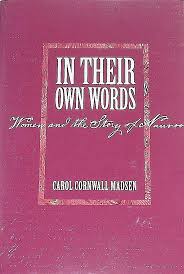Articles/Essays – Volume 28, No. 3
Sustained by Faith and Community | Carol Cornwall Madsen, ed., In Their Own Words: Women and the Story of Nauvoo
Carol Cornwall Maden’s In Their Own Words: Women and the Story of Nauvoo brings together accounts of life in Nauvoo, Illinois, by about two dozen LDS women, some well known, some relatively obscure. Professor Madsen’s introduction details the “kinship” networks these women formed through mutual help and sup port, discusses their avid participation in the Relief Society and temple ordinances, and argues that their deep faith and sense of community helped them cope with sickness, shortages of food and shelter, and persecution during the troubled years of the early 1840s. Primary selections are arranged by genre—diaries, letters, and reminiscences—with brief introductory notes discussing each form. Before each individual selection Professor Madsen provides a brief biography of the writer and highlights important aspects of theme and style.
The volume attests directly that it provides a “testament to the compel ling power of faith” (29), and selections (and the introductory essay) uniformly give a picture of heroic, devout, caring women, a true sisterhood of Saints. We see women suffering, but they remain exemplary. Though the voices are varied and individual, the picture is uniformly uplifting. Professor Madsen does note generally in her introduction that “these women were selective in what they recorded, and the reader [and the historian] must always recognize the historical limitations of personal discourse” (x), but the internal commentary sidesteps “touchy” issues (we read, for instance, diary entries by Eliza Snow from the days when she was first married to Joseph Smith, but Professor Madsen does not discuss Emma Smith’s opposition to polygamy). This is ultimately a valedictory volume, not an analytical one, and some readers might wish that the overall image were a bit more rounded.
That said, it is also a delightful volume. The selections vary consider ably in tone, length, and content, testifying to the various ways that the writers coped with adversity, and, as Professor Madsen emphasizes, to the writers’ persistent conviction of the truth of LDS teachings. Some passages are full of pathos, like Sarah Decker’s reminiscences about sitting up with her father’s corpse after the Battle of Nauvoo; some are angry, like Elizabeth Heward’s comments on the irony of LDS men being asked to volunteer for the U.S. Army immediately after they had been driven from their homes. Others are elegant in their directness and restraint, like Drusilla Hendricks’s account of her family’s struggle to keep food on the table. Nearly all present vital details that make the writers live as individuals, like the story of Bathsheba Smith, who carefully cleaned her Nauvoo house before leaving it forever for the west. Some particularly interesting letters reflect the writers’ efforts to convert non-LDS relatives using a variety of tactics: “How long do you think we might have stayed in Eng. before we could have a cow?” (117) writes Ellen Douglas, shortly before insisting to her parents that “the day will come when you will know that I have told you the truth” (118).
Professor Madsen’s focus on the Nauvoo years is a particularly good one, for it not only allows for a greater depth of information about the social and spiritual life of women in one particular time and place, but also builds a chorus of voices speaking of a shared experience. And that shared experience was, as Professor Madsen argues, central in these lives, “a time when events seemed larger than life” (159). As this cohort of women writes of conversions and new lives in Nauvoo, it becomes clear how crucial their shared community of faith was to their self-definition.
Whether the reader is LDS and interested in “reaffirming the reality of our spiritual heritage” (xii) or simply interested in the way that spiritual life informs women’s psychology, this is an interesting, valuable work. It may not give the whole truth about the lives of all women in Nauvoo, but the truth that it gives is resonant and moving, and the reader is left, indeed, feeling that he or she has been touched by the voices of vivid human beings at a pivotal point in their lives.
In Their Own Words: Women and the Story of Nauvoo. Edited by Carol Cornwall Madsen (Salt Lake City: Deseret Book Co., 1994).


 Back to full Issue
Back to full Issue

